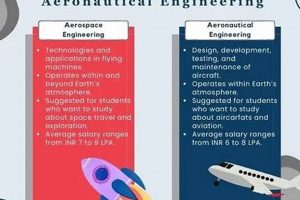The application of the C++ programming language within the field concerned with the design, development, testing, and production of aircraft and spacecraft allows for sophisticated modeling and simulation. For instance, this language is utilized in creating flight control systems, simulating aerodynamic forces, and optimizing satellite trajectories. The key characteristic is its ability to handle complex numerical computations and provide efficient code execution, critical for real-time applications common in the domain.
Its significance stems from the capacity to manage the inherent complexity of related projects. This language provides a balance between high-level abstractions and low-level control, allowing engineers to model intricate physical systems with precision and optimize performance-critical operations. Historically, the use of this language offered a substantial advantage over older languages due to its object-oriented programming capabilities and memory management features, enabling the development of more robust and maintainable software.
Subsquent topics will cover specific areas where C++ plays a pivotal role, including guidance and navigation systems, computational fluid dynamics (CFD) simulations, and the development of embedded systems for onboard control units. Further discussion will explore best practices for utilizing this language in compliance with industry standards and safety requirements, highlighting its ongoing relevance in advancing the current and future state of the industry.
Tips for Utilizing C++ in Aerospace Engineering
The following offers guidance on effectively employing the capabilities of a specific programming language within the broader field of aerospace engineering. These tips are intended to improve the efficiency and reliability of software development in this demanding industry.
Tip 1: Master Numerical Libraries: Familiarize oneself with established numerical libraries such as BLAS, LAPACK, or Eigen. These libraries provide highly optimized routines for linear algebra, crucial in simulations and control systems. Utilize these libraries instead of writing custom implementations to ensure accuracy and performance.
Tip 2: Prioritize Real-Time Performance: In many applications, particularly in flight control and embedded systems, real-time performance is paramount. Employ techniques such as memory pre-allocation, minimizing dynamic memory allocation during runtime, and avoiding excessive virtual function calls to optimize execution speed.
Tip 3: Employ Thorough Testing and Validation: Implement rigorous testing procedures, including unit testing, integration testing, and system-level testing. Use static analysis tools to detect potential errors and vulnerabilities in the code. Comprehensive testing is essential to ensure the reliability and safety of software used in aerospace applications.
Tip 4: Adhere to Coding Standards: Follow industry-standard coding guidelines, such as MISRA C++ or similar, to improve code readability, maintainability, and portability. Consistent code formatting and documentation practices contribute to a more collaborative and error-resistant development process.
Tip 5: Leverage Object-Oriented Programming: Utilize the object-oriented features of the language, such as encapsulation, inheritance, and polymorphism, to model complex aerospace systems in a modular and reusable manner. This approach promotes code organization and reduces code duplication.
Tip 6: Profile and Optimize Performance Bottlenecks: Employ profiling tools to identify performance bottlenecks in the code. Optimize critical sections of the code by using appropriate data structures, algorithms, and compiler optimizations. Avoid premature optimization; focus on optimizing code that has been identified as a bottleneck through profiling.
Tip 7: Carefully Manage Memory: Memory leaks and improper memory management can lead to system instability and crashes. Utilize smart pointers, such as `std::unique_ptr` and `std::shared_ptr`, to automate memory management and prevent memory leaks. Be mindful of memory fragmentation and consider using custom memory allocators for performance-critical applications.
Following these tips aids in developing robust, efficient, and reliable software. Utilizing these strategies allows engineers to confidently harness the power of a specific programming language in the field, ensuring successful project execution and promoting advancements.
The subsequent sections will provide a deeper investigation into specific applications within aerospace engineering where the previously mentioned techniques are applied to solve complex problems and achieve tangible results.
1. Real-time System Control
Real-time system control is a crucial aspect of aerospace engineering, necessitating deterministic execution of software to ensure timely responses to dynamic events. The implementation of such systems with a specific programming language demands careful consideration of timing constraints, resource management, and fault tolerance.
- Deterministic Execution
Aerospace applications, such as flight control systems and engine management units, require predictable and consistent execution times. Employing real-time operating systems (RTOS) and careful coding practices minimizes variability in execution time. The use of pre-emptive scheduling and priority-based task management ensures that critical tasks are executed promptly, preventing system instability or failure. For example, maintaining stable aircraft flight requires precise control surface adjustments based on sensor data; delays in processing this data could lead to hazardous outcomes.
- Resource Management
Real-time systems typically operate under stringent resource constraints, including limited memory and processing power. Efficient memory management techniques, such as static allocation and avoiding dynamic memory allocation during runtime, are crucial. Optimizing code for minimal resource consumption reduces latency and improves overall system responsiveness. Power budget is another essential resource that needs to be carefully managed. The use of appropriate data structures and algorithms can minimize the computational load on the processor.
- Fault Tolerance
Due to the safety-critical nature of many aerospace applications, fault tolerance is paramount. Implementing redundancy, error detection, and error correction mechanisms is essential to ensure continued operation in the presence of hardware or software failures. Watchdog timers, exception handling, and fault isolation techniques are commonly employed. For instance, a flight control system may have redundant sensors and actuators, allowing it to continue functioning even if one or more components fail.
- Data Acquisition and Processing
Real-time systems often require the acquisition and processing of data from sensors and other external sources. Efficient data acquisition techniques, such as direct memory access (DMA), minimize processor overhead. Data processing algorithms must be optimized for speed and accuracy. Filtering techniques can be used to reduce noise and improve data quality. Calibration routines and sensor fusion algorithms combine data from multiple sensors to provide a more accurate and reliable representation of the system state.
The effective application of a specific programming language in real-time system control within the aerospace domain hinges on a deep understanding of these facets. The ability to design and implement software that meets stringent timing requirements, manages resources efficiently, and tolerates faults reliably is critical to ensuring the safety and performance of modern aircraft and spacecraft.
2. Numerical Simulation Efficiency
The efficient execution of numerical simulations is a cornerstone of modern aerospace engineering practices. Software developed using C++ enables engineers to model complex phenomena such as fluid dynamics, structural mechanics, and thermal transfer with a degree of fidelity and speed previously unattainable. The performance gains achieved through the utilization of this language directly impact the ability to conduct comprehensive design studies, optimize system performance, and reduce development time. For example, computational fluid dynamics (CFD) simulations, essential for aerodynamic design, rely on iterative numerical solvers. Faster solver convergence rates, facilitated by efficient C++ implementations, allow engineers to evaluate a greater number of design iterations within a given timeframe. This, in turn, leads to improved aerodynamic performance and fuel efficiency.
Another area where efficient numerical simulation is crucial is in structural analysis. Finite element analysis (FEA) software, often written in C++, is used to predict the stress and strain distributions within aerospace structures under various loading conditions. Efficient FEA simulations enable engineers to optimize structural designs, reduce weight, and ensure structural integrity. The ability to accurately model complex material behavior and nonlinear effects is often predicated on the availability of high-performance computing resources and optimized C++ code. Furthermore, the simulation of space environments, including radiation effects and micrometeoroid impacts, requires computationally intensive Monte Carlo methods. Efficient C++ implementations allow engineers to assess the long-term reliability and performance of spacecraft components operating in harsh conditions.
In conclusion, the connection between numerical simulation efficiency and the utilization of C++ within aerospace engineering is symbiotic. Efficient simulations drive design innovation and optimization, leading to improved performance, safety, and cost-effectiveness. Ongoing efforts to develop and refine numerical algorithms, coupled with the continued advancement of C++ compilers and hardware architectures, will further enhance the role of simulation in shaping the future of aerospace technology. Challenges remain in managing the complexity of large-scale simulations and ensuring the accuracy and reliability of results, but the benefits of efficient numerical simulation are undeniable.
3. Reliable Flight Software
The development of reliable flight software is intrinsically linked to the application of C++ in aerospace engineering. The robustness and dependability of flight systems directly impact safety and mission success. The choice of C++ stems from its capacity to deliver high performance while maintaining a level of control necessary for complex systems. The relationship is causal: employing C++ allows for detailed modeling of aircraft dynamics, control system algorithms, and sensor integration, which are all prerequisites for reliable operation. Its importance cannot be overstated; flight software errors can lead to catastrophic failures. For example, unintended acceleration issues in aircraft have been attributed to software glitches, demonstrating the critical need for reliable code. Practical significance lies in the ability to develop and validate software that functions predictably and consistently under a range of conditions.
Further analysis reveals that specific aspects of C++ contribute to achieving high levels of reliability. These include object-oriented programming principles that promote modularity and code reusability, reducing the likelihood of errors. Memory management capabilities, when correctly implemented, prevent memory leaks and other resource-related issues that can lead to system instability. Additionally, established coding standards and testing methodologies tailored for safety-critical systems are commonly applied in conjunction with C++ development to ensure compliance with regulatory requirements and industry best practices. Real-world applications include the flight control systems of commercial airliners, autonomous navigation systems for unmanned aerial vehicles, and attitude control systems for satellites, all of which depend on reliable software for their safe operation.
In summary, reliable flight software is a vital component of modern aerospace engineering. The judicious use of C++ enables the creation of software that meets the stringent requirements for performance, safety, and dependability. Challenges remain in verifying and validating increasingly complex software systems, requiring ongoing research and development in formal methods, static analysis techniques, and advanced testing methodologies. The continued emphasis on reliability in flight software is crucial for maintaining public trust in air travel and enabling future advancements in aerospace technology.
4. Embedded System Optimization
The connection between embedded system optimization and C++ within aerospace engineering is crucial for achieving high performance and reliability. Embedded systems, which are specialized computer systems designed to perform dedicated functions, are integral components of aircraft and spacecraft, managing critical tasks such as flight control, navigation, and sensor data processing. C++, due to its ability to provide both high-level abstractions and low-level hardware control, serves as a primary language for developing software for these embedded systems. The optimization of these systems is, therefore, a necessity for maximizing efficiency and minimizing resource consumption, directly affecting the overall performance and safety of aerospace vehicles. For example, optimizing the flight control software in a commercial airliner reduces latency and improves the precision of control surface adjustments, enhancing stability and fuel efficiency. This directly results in enhanced fuel efficiency and passenger comfort.
Embedded system optimization in aerospace C++ applications encompasses a range of techniques, including code profiling, memory management, and algorithm selection. Code profiling identifies performance bottlenecks, allowing developers to focus on optimizing the most resource-intensive sections of the code. Efficient memory management, achieved through techniques such as static allocation and the use of smart pointers, prevents memory leaks and reduces the risk of system crashes. Furthermore, the selection of appropriate algorithms, tailored to the specific hardware and software constraints of the embedded system, can significantly improve performance. For instance, using fixed-point arithmetic instead of floating-point arithmetic can reduce computational overhead and power consumption in resource-constrained environments. The practical applications of these techniques are vast, ranging from improving the responsiveness of avionics systems to extending the operational life of satellite components.
In summary, embedded system optimization is a pivotal aspect of C++ programming within aerospace engineering. It enables the creation of efficient, reliable, and safe aerospace systems. The challenges involve managing complexity, ensuring real-time performance, and adhering to stringent safety standards. Ongoing research and development efforts continue to focus on advancing embedded system optimization techniques, addressing the evolving demands of modern aerospace technology. Understanding this connection is critical for aerospace engineers striving to push the boundaries of what is possible.
5. Safety-Critical Code Design
Safety-critical code design represents a paramount concern within aerospace engineering, particularly when employing C++. The integrity of such code directly impacts the safety of human life and mission success. Stringent development processes, rigorous testing, and adherence to industry standards are crucial to mitigating risks associated with software failures. This exploration examines key facets of designing code where failure carries severe consequences, illustrating the meticulousness required in this specialized field.
- Formal Verification
Formal verification involves using mathematical techniques to prove the correctness of software. This approach provides a high degree of confidence that the code behaves as intended under all possible conditions. Within the domain, formal methods are applied to critical components such as flight control algorithms and autopilot systems. For example, verifying the absence of division-by-zero errors or buffer overflows can prevent catastrophic failures during flight. While resource-intensive, the enhanced reliability afforded by formal verification justifies its use in safety-critical areas.
- Coding Standards and Guidelines
Adherence to established coding standards, such as MISRA C++, is essential for safety-critical development. These standards impose rules and restrictions on coding practices to minimize ambiguity, prevent common programming errors, and improve code maintainability. For instance, MISRA C++ prohibits the use of dynamic memory allocation in safety-critical systems to avoid memory leaks and fragmentation. Following these guidelines promotes code clarity, reduces the likelihood of errors, and facilitates independent code review, crucial for verifying the correctness of safety-critical software.
- Redundancy and Fault Tolerance
Redundancy and fault tolerance are key strategies for mitigating the impact of software or hardware failures in aerospace systems. Implementing redundant code paths, diverse programming techniques, and error-detection mechanisms ensures continued operation even in the presence of faults. For example, a flight control system may employ multiple independent processors running identical or diverse software versions. If one processor fails, another can seamlessly take over, maintaining control of the aircraft. The increased complexity and cost associated with redundancy are justified by the enhanced safety and reliability it provides.
- Rigorous Testing and Validation
Comprehensive testing and validation are essential for ensuring the correctness and reliability of safety-critical code. Testing encompasses a range of techniques, including unit testing, integration testing, system testing, and formal testing. Unit tests verify the functionality of individual code modules, while integration tests assess the interaction between different modules. System tests evaluate the overall system behavior under realistic operating conditions. Formal testing employs mathematical techniques to verify the code against formal specifications. Each stage of testing aims to detect and eliminate errors before deployment, minimizing the risk of failure in flight.
These facets highlight the rigorous and systematic approach required for safety-critical code design in aerospace applications utilizing C++. The convergence of formal methods, coding standards, redundancy, and testing creates a framework for producing software that meets the highest standards of reliability and safety. Continued advancements in software engineering techniques and validation methodologies will further enhance the integrity of aerospace systems, ensuring the safety of passengers and the success of future missions.
Frequently Asked Questions
This section addresses common queries regarding the application of a specific programming language within the aerospace engineering field. The goal is to provide clear, concise answers to enhance understanding and dispel misconceptions.
Question 1: Why is this programming language favored in aerospace engineering despite the existence of other languages?
This language offers a unique combination of high performance, low-level control, and mature libraries. This balance enables the development of efficient and reliable software for real-time systems, numerical simulations, and embedded applications, where performance is paramount.
Question 2: What are the key challenges associated with using this language in safety-critical aerospace systems?
The primary challenges involve ensuring code reliability, managing memory efficiently, and adhering to stringent safety standards. The complexity of aerospace systems necessitates meticulous development processes, rigorous testing, and formal verification techniques to mitigate potential risks.
Question 3: How does this language contribute to numerical simulation efficiency in aerospace engineering?
This language facilitates the development of optimized numerical solvers and algorithms, enabling engineers to conduct complex simulations of aerodynamic forces, structural behavior, and thermal transfer phenomena. The speed and accuracy of these simulations are crucial for design optimization and performance prediction.
Question 4: What role does this language play in the development of reliable flight software?
This language allows for the creation of modular, reusable, and maintainable code, which is essential for minimizing errors and ensuring the reliability of flight software. Its memory management capabilities and object-oriented programming features contribute to the development of robust and dependable systems.
Question 5: How does this language enable the optimization of embedded systems in aerospace applications?
This language provides the necessary tools for fine-grained control over hardware resources, allowing engineers to optimize embedded systems for performance, power consumption, and memory usage. This capability is crucial for maximizing the efficiency and lifespan of aerospace components.
Question 6: What coding standards and guidelines are typically followed when using this language in aerospace projects?
Adherence to established coding standards, such as MISRA C++, is common practice in safety-critical aerospace development. These standards impose rules and restrictions on coding practices to minimize ambiguity, prevent common programming errors, and improve code maintainability. These guidelines are designed to enhance software reliability and reduce the likelihood of failures in mission-critical systems.
In summary, the selection and application of this programming language require a comprehensive understanding of its strengths, limitations, and best practices within the context of aerospace engineering. Careful planning, rigorous testing, and adherence to industry standards are essential for achieving success.
The subsequent section will explore future trends in the utilization of this language within the aerospace field, examining emerging technologies and potential areas for innovation.
Conclusion
The preceding exploration of aerospace engineering cpp has illuminated its pivotal role in the advancement of modern aviation and space exploration. Its application spans a multitude of critical domains, from real-time control systems to high-fidelity numerical simulations, enabling engineers to design, analyze, and optimize complex aerospace vehicles and components. The ability of aerospace engineering cpp to balance high performance with low-level control makes it an indispensable tool in this demanding field.
As aerospace technology continues to evolve, the importance of aerospace engineering cpp will only increase. Future endeavors will require increasingly sophisticated software solutions to meet the challenges of autonomous flight, space colonization, and hypersonic travel. Therefore, continued investment in research, education, and standardization within the field of aerospace engineering cpp is essential to ensure the safety, reliability, and success of future aerospace missions.







